It‘s super easy to make authentic and homemade Japanese Miso Soup! In this recipe, I show you how to make quick and easy soup stock (dashi) from scratch, then create classic miso soup with tofu and wakame seaweed. It‘s delicious and has many health benefits.
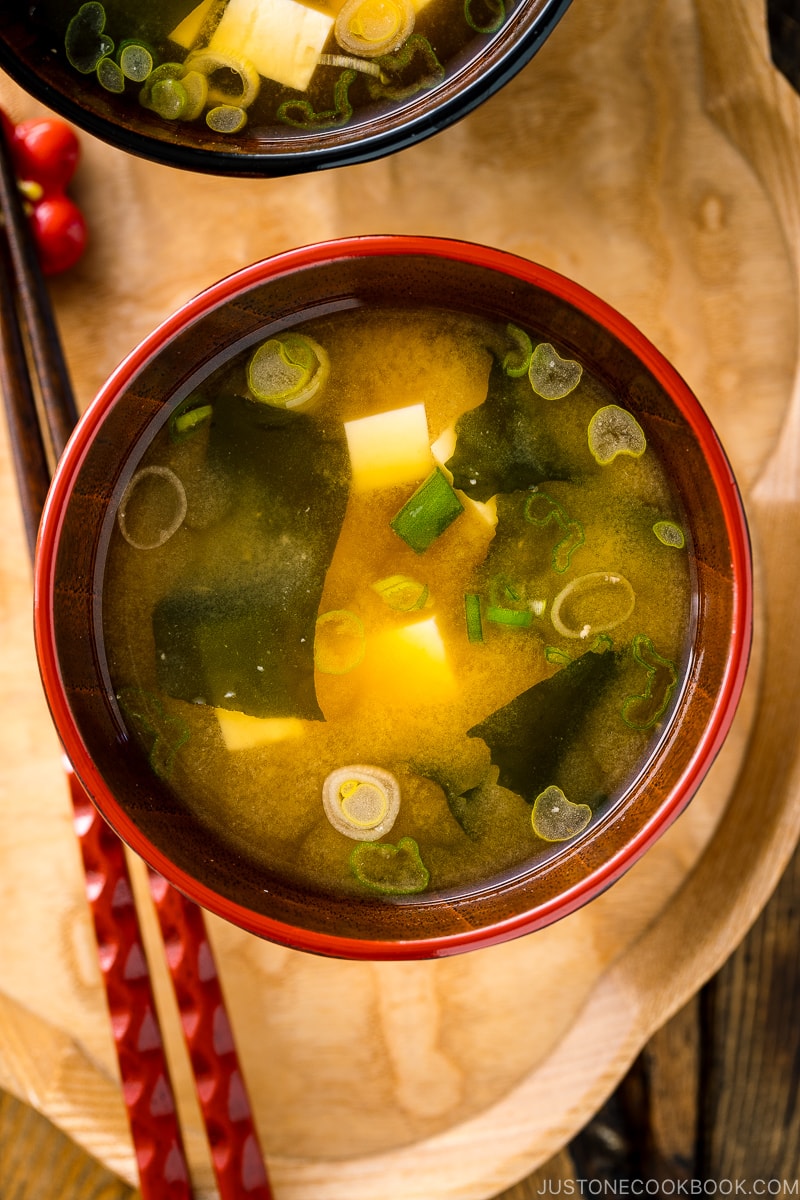
Miso soup is one of those simple joys in life—comforting, nourishing, and incredibly easy to make. We enjoy it daily for breakfast, lunch, or dinner.
Once you master the basics, you can customize it to your taste. This guide will show you how to make authentic miso soup at home—better than any restaurant or instant version!
If you love miso soups, try my Tonjiru, Kabocha Miso Soup, and Kenchinjiru recipes next!
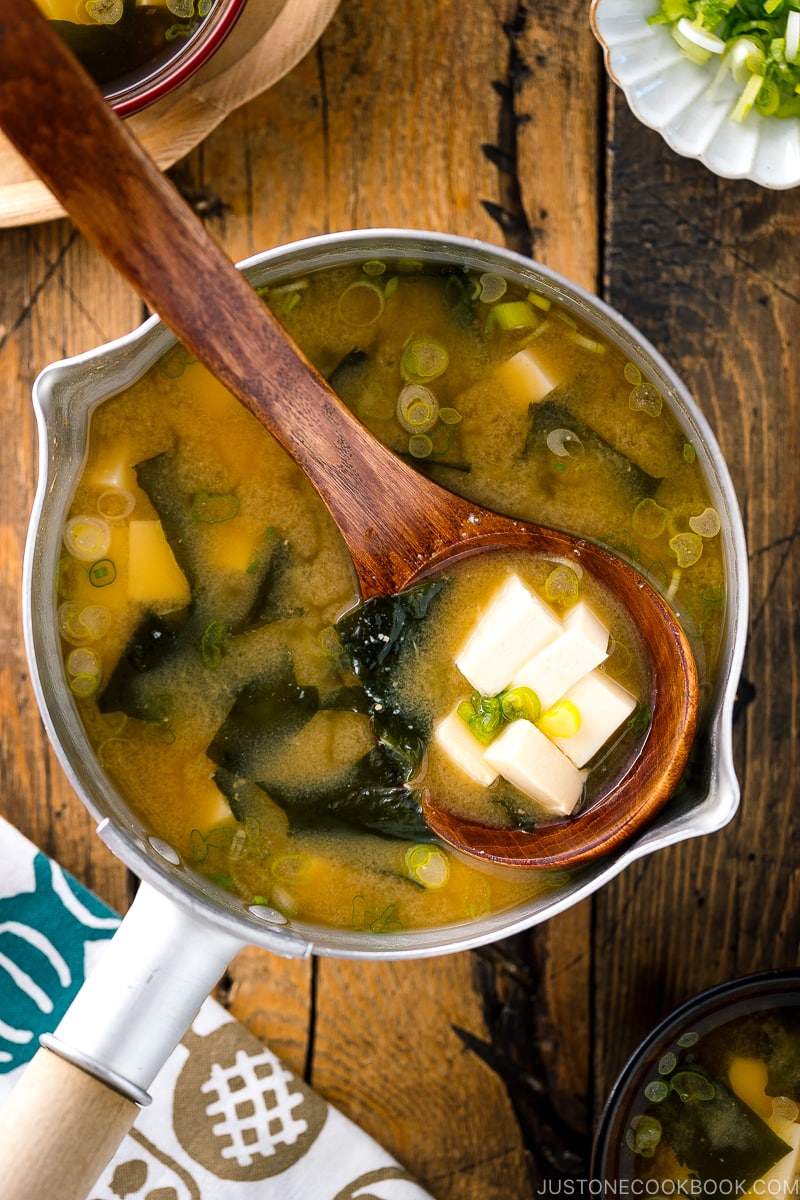
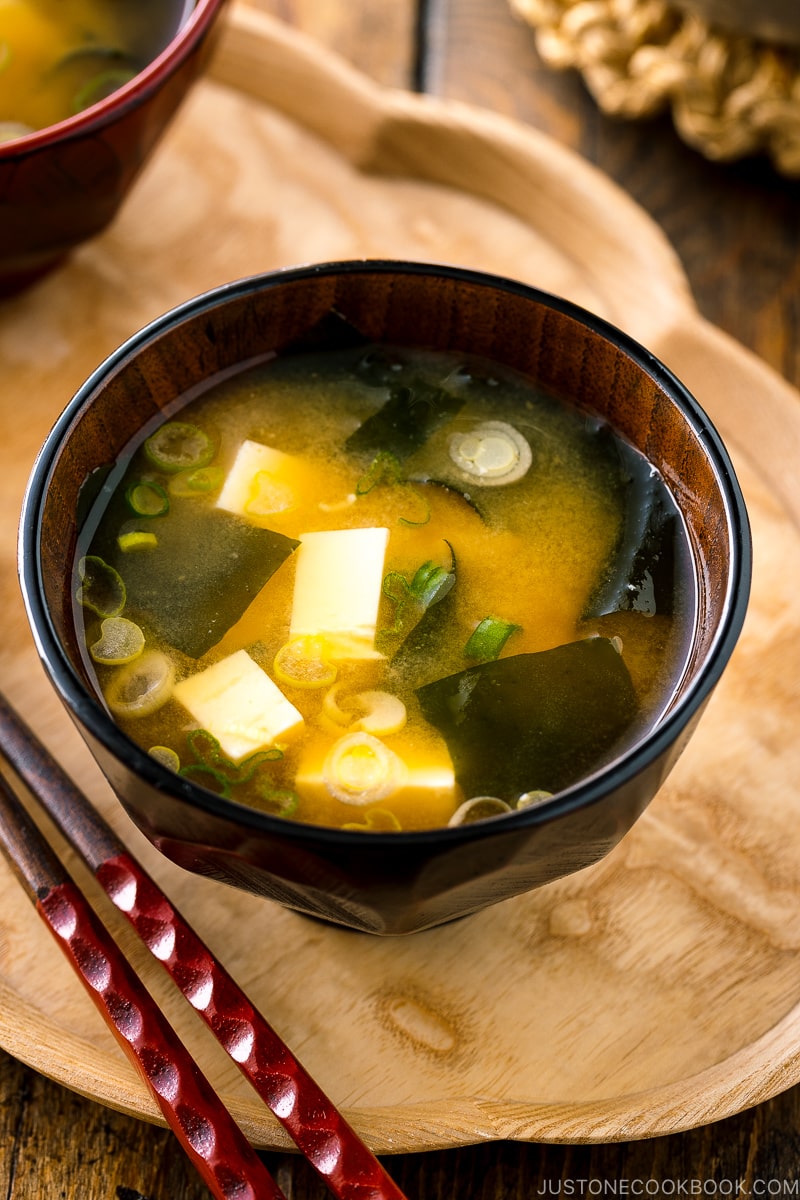
What is Miso Soup?
Miso soup (味噌汁, miso shiru) is a traditional Japanese soup made from a miso paste mixed into dashi (Japanese soup stock). It often includes ingredients like tofu, seaweed, green onions, and vegetables, with variations depending on the region and season. A staple in Japanese cuisine, miso soup is enjoyed as a side dish with meals, offering a comforting umami flavor and numerous health benefits.
If you are already familiar with making miso soup, check out my Seasonal Miso Soup Recipe Collection.
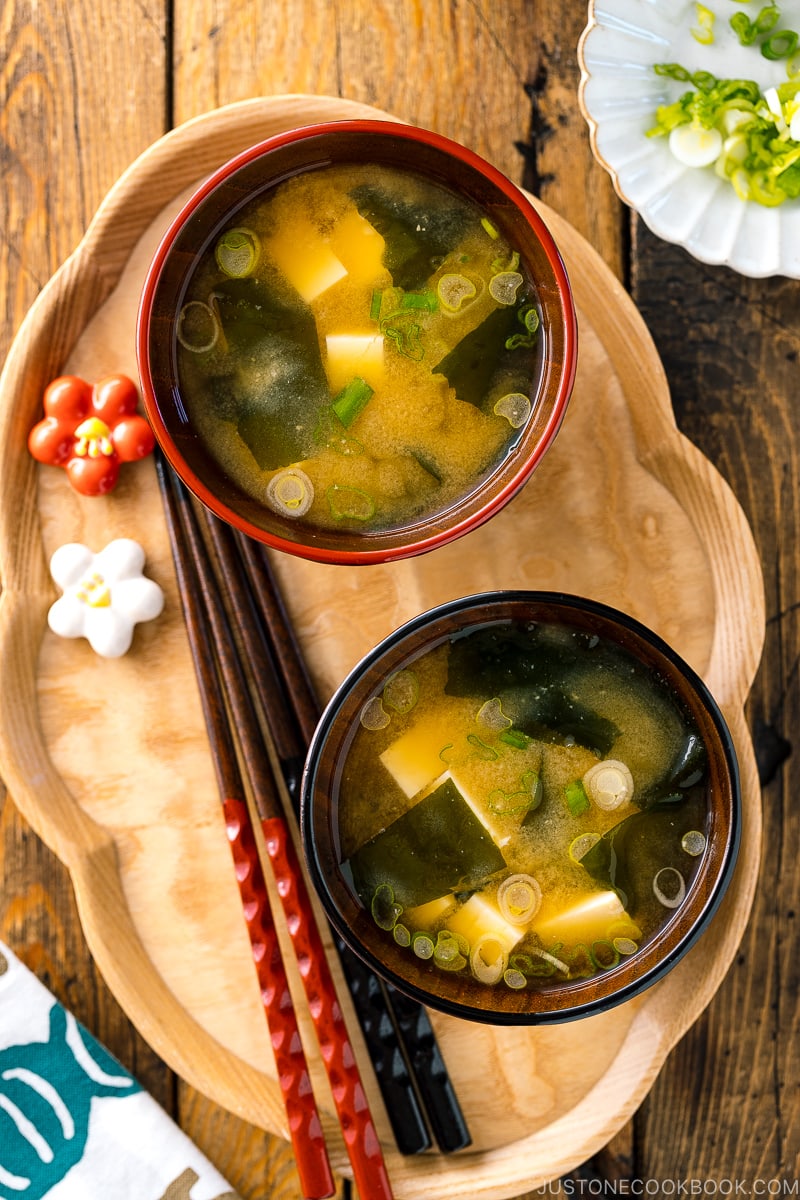
Basic Ingredients You’ll Need
Let’s master the classic version with tofu and wakame seaweed. The ingredients include:
- Dashi (Japanese soup stock) — The heart of authentic miso soup. We’ll dive into it below!
- Miso paste
- Tofu (silken or medium-firm, cut into cubes)
- Dried wakame seaweed
- Green onions (chopped)
3 Simple Steps to Make Miso Soup
Making miso soup is easy when you break it down into three simple steps:
- Make dashi (Japanese soup stock) – 20 minutes
- Add miso – 2 minutes
- Add tofu and wakame, then serve – 3 minutes
Once you’ve mastered this basic recipe, you can easily customize your miso soup with different ingredients for endless variations.
Step 1: Make Dashi
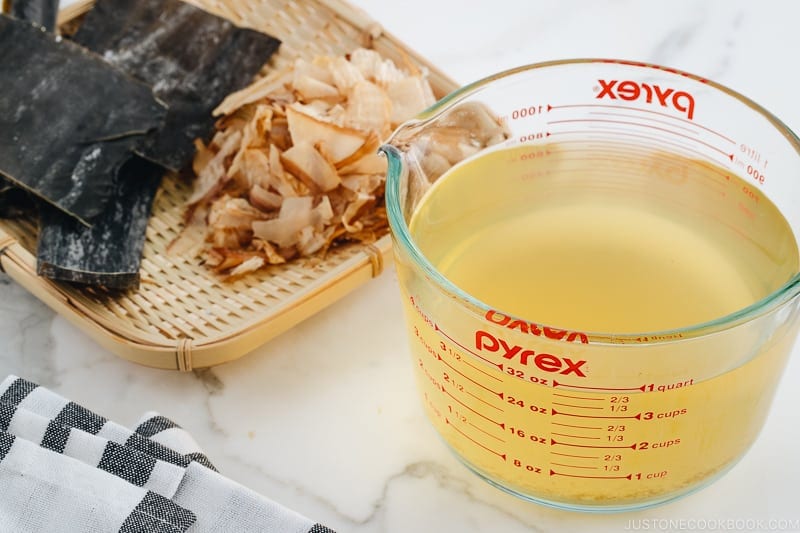
What is Dashi?
Dashi (だし, 出汁) is a fundamental Japanese soup stock and the backbone of many Japanese dishes. It’s incredibly quick and easy to prepare, making it an essential component of authentic miso soup. Unlike chicken or vegetable stock, dashi provides the signature umami flavor that defines true Japanese cuisine—without it, it’s simply not miso soup.
- Awase Dashi — This is the most common dashi made from kombu (kelp) and katsuobushi (dried bonito flakes).
- Kombu Dashi — This dashi is made solely from kombu (kelp). It’s plant-based.
- Vegan Dashi — This dashi combines kombu and dried shiitake mushrooms for a rich, umami-packed broth.
- Iriko Dashi — This dashi uses dried anchovies for a deeper, briny flavor. It’s a popular choice for miso soup in Japan.
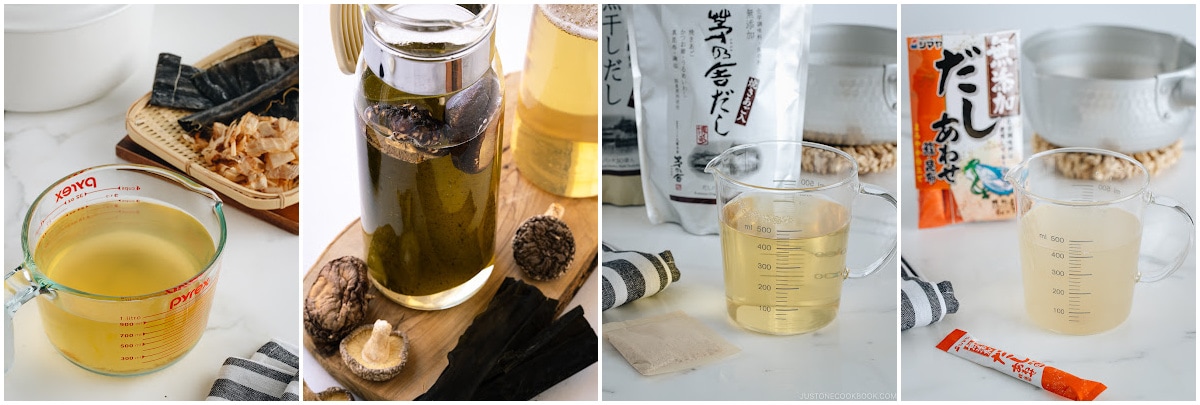
There are three main ways to make dashi, each with its own balance of flavor and convenience.
- Homemade dashi (best flavor & quality) —To make Awase Dashi, simply soak kombu in cold water, heat it just below boiling, then add bonito flakes and let it steep briefly before straining. For Kombu Dashi or Vegan Dashi, a cold brew method works best—just soak the kombu in the water ahead of time for a naturally deep flavor before steeping briefly.
- Dashi packet (best shortcut) — A dashi packet is my go-to shortcut when I’m short on time. Just like brewing tea, you steep the packet in hot water for a couple of minutes, and you’re left with a flavorful broth that’s surprisingly close to homemade.
- Dashi powder (fastest, but least flavorful) — Dashi powder (or granules) is the quickest method—just dissolve it in hot water, and you’re done. While convenient, the flavor tends to be weaker and fades quickly, so I only use this when I have no other options.
Pro Tip: Dashi is a staple in Japanese cooking, adding a deep umami flavor to many dishes. Make a big batch and store it in the refrigerator for 3–5 days or freeze it for up to two weeks. With dashi ready to go, you can whip up a comforting bowl of miso soup in under 5 minutes!
Step 2: Add Miso Paste
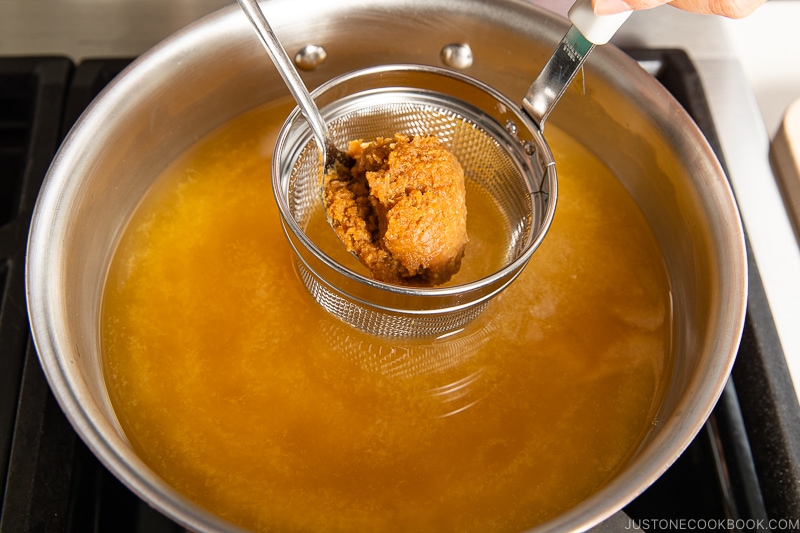
What is Miso?
Miso (味噌) or fermented soybean paste is made from soybeans, grains (steamed rice or barley), salt, and koji culture (麹, a fermentation starter).
There are many types of miso available, each with its own unique flavor. In the U.S., grocery stores typically categorize miso by color: white miso (shiro miso) for a mild, slightly sweet taste, red miso (aka miso) for a deeper, bolder flavor, and yellow miso (awase miso or mixed miso) as a balanced option. Want to dive deeper? Check out our detailed guide on miso!
Miso varies in saltiness and flavor, so there’s no “right” miso for miso soup. Adjust the amount to taste, or blend two or three types for more complexity. If you have a high-quality miso, enjoy its unique flavor on its own!
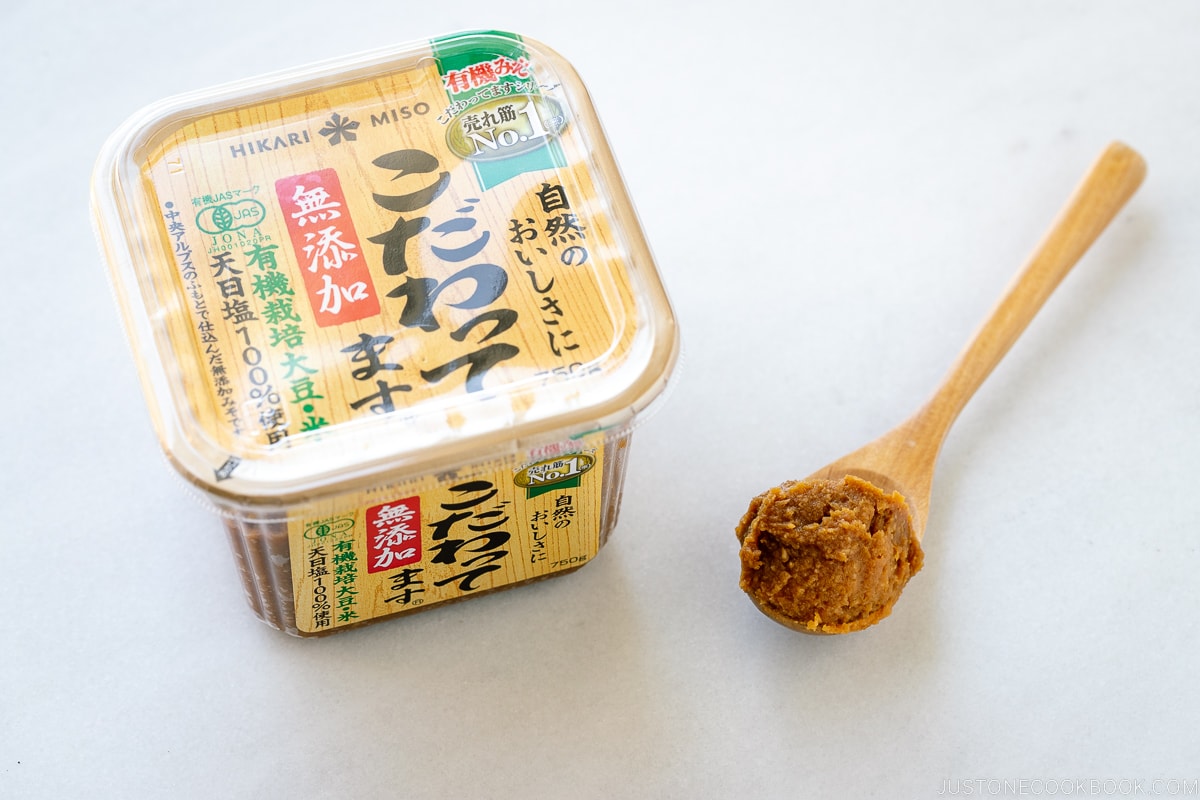
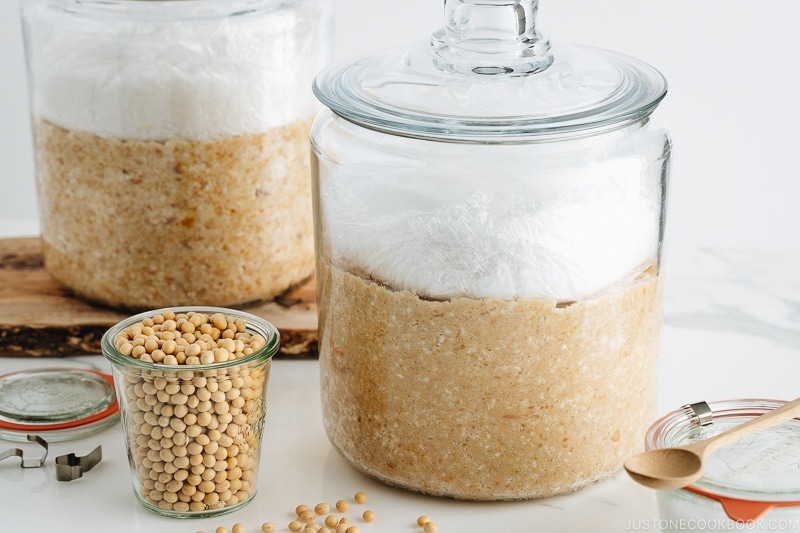
- My favorite miso is this Kodawattemasu from Hikari Miso (organic slow-aged red koji miso). It has a more rounded character that goes well with any ingredients.
- If you want to make miso from scratch, check out my How to Make Homemade Miso post.
- Dashi-included miso (だし入り味噌) may be convenient, but it lacks the health benefits of fresh miso. Manufacturers add additives and sterilize them to preserve quality, which stops the action of beneficial yeasts. For better taste and health benefits, it’s best to use traditional miso and prepare your own dashi.
How Much Miso Paste to Add to the Soup?
- In Japan, the general rule of thumb is to add one tablespoon (18 g) of miso paste per miso soup bowl (200 ml).
When you add miso paste, make sure to turn off the heat before adding miso paste to avoid accidentally boiling the soup.
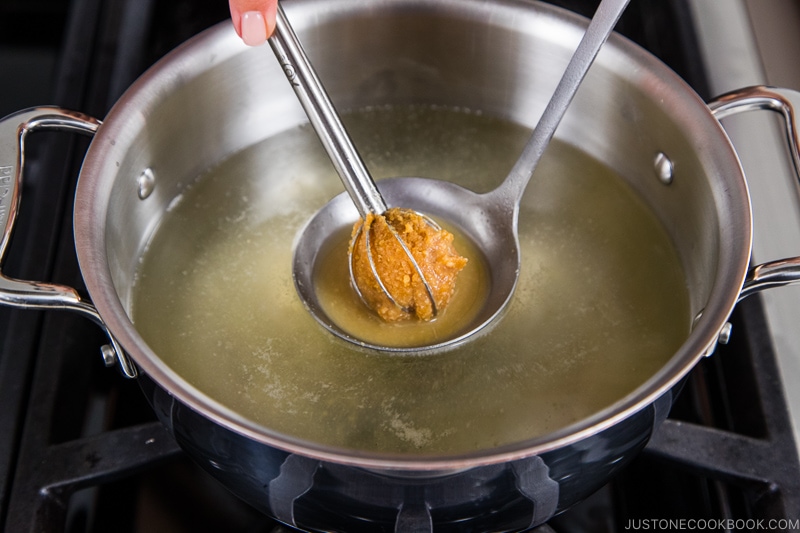
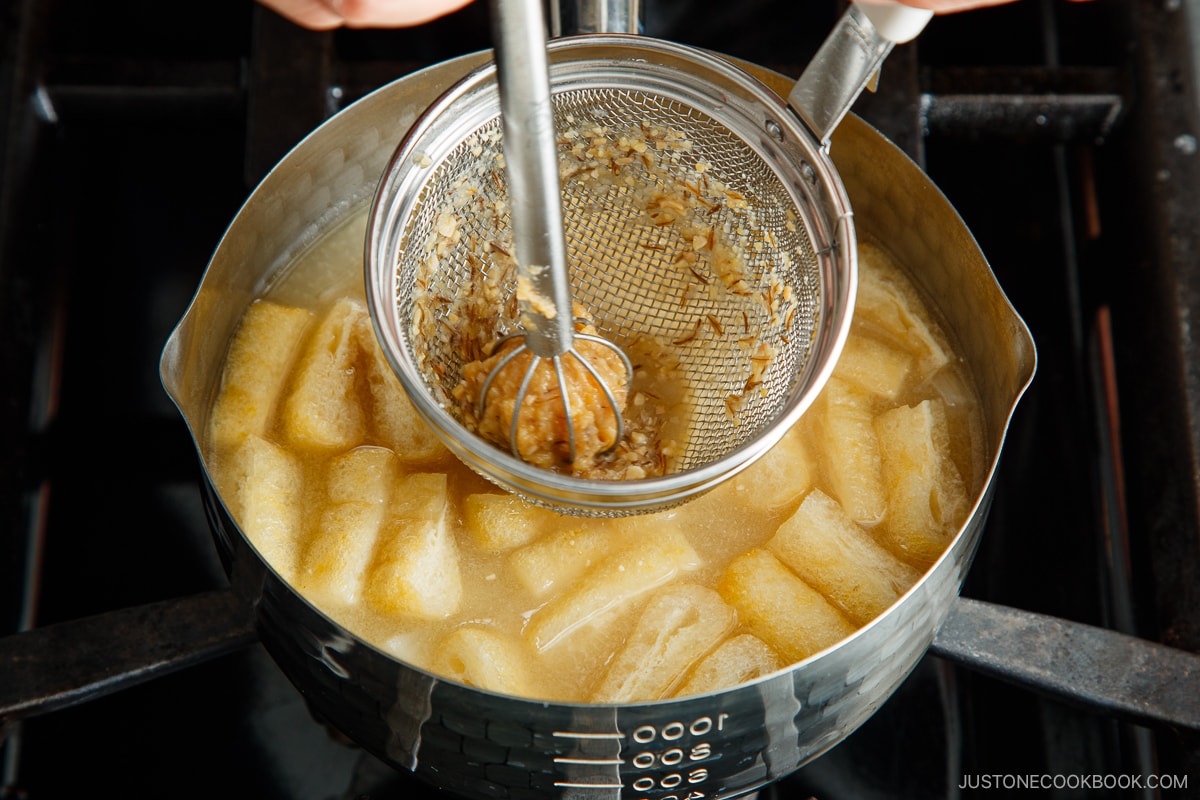
Always dissolve the miso paste first in a ladle or separate bowl—never add it directly to the soup. Other kitchen tools I like:
- Miso Muddler (my favorite) – one side measures 2 Tbsp and the other 1 Tbsp to help dissolve miso.
- Fine-mesh strainer – to ensure smooth miso without clumps.
When Do You Add Miso Paste?
- Add miso paste to dashi right before serving to preserve its best flavor and aroma. Miso will lose its fragrance if reheated multiple times.
- Before adding the miso, bring the dashi to a slow boil, around 205°F (96°C). This is an ideal temperature for releasing the most fragrant notes of the miso soup. By the time you’re ready to enjoy it, the soup will be at a perfect drinking temperature of 167°F (75°C).
Step 3: Add Tofu to the Soup
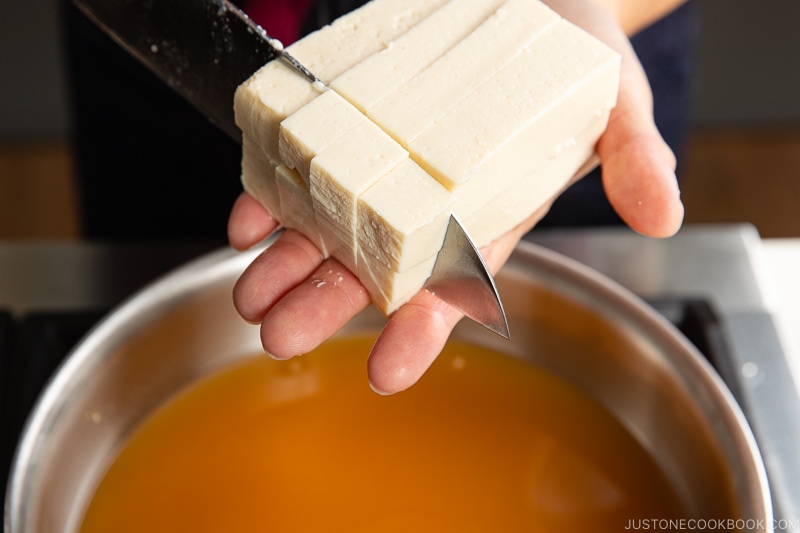
To avoid breaking the tofu, always add it after dissolving the miso paste. This helps keep the tofu intact and ensures a smoother texture in your soup. Since tofu doesn’t require cooking, you just need to warm it up.
- Silken or medium tofu? In Japan, silken tofu (kinugoshi tofu 絹ごし豆腐) is slightly more popular than medium tofu (momen tofu 木綿豆腐), but both tofu are common in miso soup. Silken tofu adds a custardy texture while medium tofu is spongier.
- In Japan, it’s common to cut tofu on your palm, as seen in dramas and anime. If you’re new to it, use a cutting board for safety. For miso soup, cut tofu into ½-inch (1.3 cm) cubes.
Along with tofu, add dried wakame and green onions at the same time.
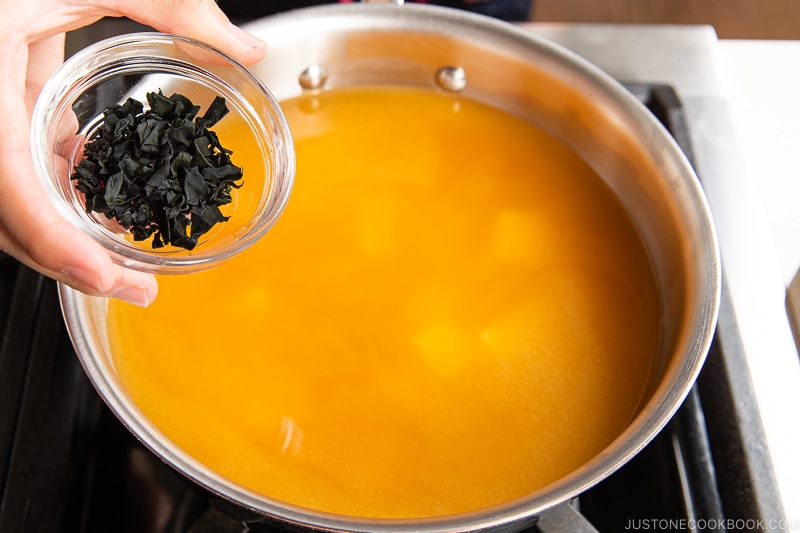
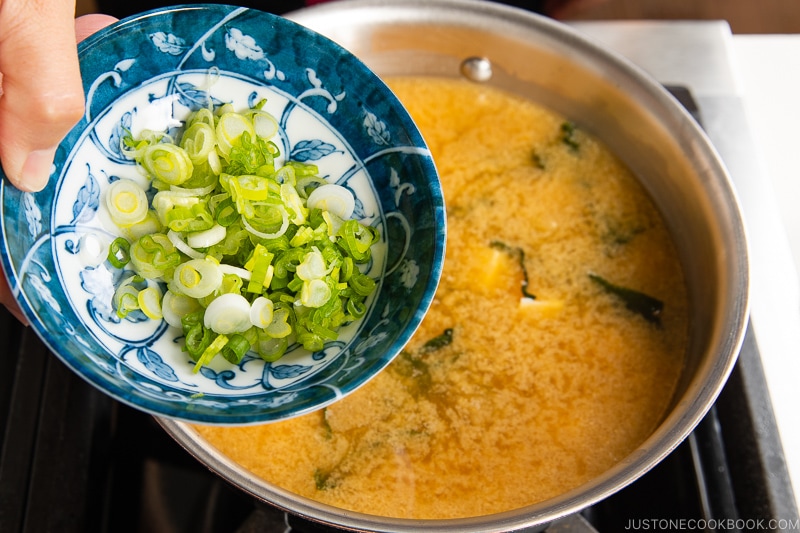
Serve miso soup immediately while it’s warm. By the time you are ready to enjoy it, the soup will be at a perfect drinking temperature of 167°F (75°C).
Reheating Miso Soup
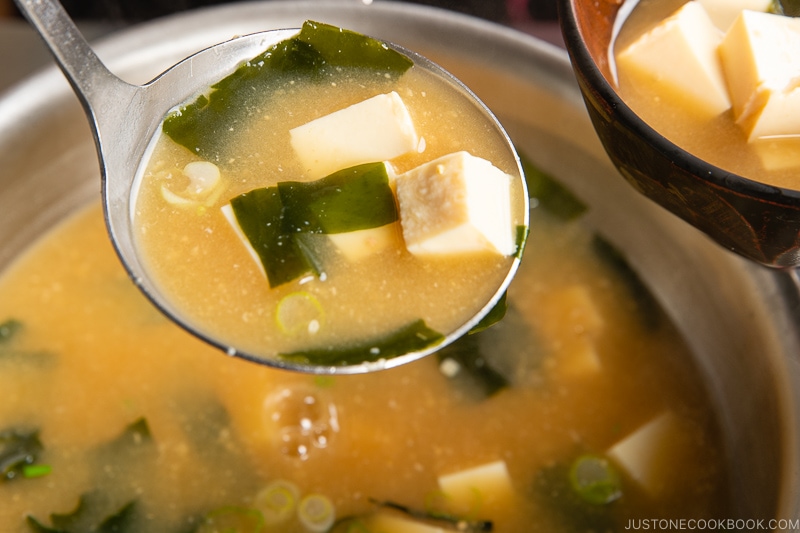
If your miso soup cools down, gently reheat it to a simmer (around 190°F/88°C), but never let it boil. Boiling diminishes its delicate flavor and aroma.
When reheating leftover miso soup, stir in about 1 tablespoon (18 g) of miso to refresh its aroma. Adjust the consistency by adding more dashi or water if needed.
Care About Miso’s Probiotics?
A common misconception is that boiling miso soup destroys its probiotics. In reality, probiotics die at temperatures above 140°F (60°C), but the main reason to avoid boiling is to preserve miso’s delicate flavor and aroma.
In Japan, miso soup is valued not just for probiotics but also for its protein, fiber, and minerals, which remain intact despite heat. To maximize probiotics, use miso in salad dressings, dips, or sauces instead.
How to Store Miso Soup
While it’s best to enjoy miso soup right away for the freshest taste and aroma, leftovers can be stored with a few precautions:
- Let miso soup cool to room temperature (within 4 hours; longer could cause spoilage) before refrigerating. You can store it in the refrigerator for up to 3–4 days.
- Miso soup can also be frozen for up to 2 weeks, but be sure to remove tofu before freezing, as its texture will change upon reheating.
- For reheating, follow the tips mentioned earlier.
Tips for Making a Big Batch
To store miso soup for later use, it’s best to refrigerate the soup without adding the miso. When you’re ready to serve, simply add the miso paste to the portion you plan to consume. This helps preserve the soup’s freshness and flavor.

How to Add More Ingredients
This is a bit more advanced topic, but I’d like to give a quick introduction to it here.
- If you’re using root vegetables, place them in cold dashi and cook until they become tender, approximately 10-15 minutes, depending on the vegetable’s density and cut sizes.
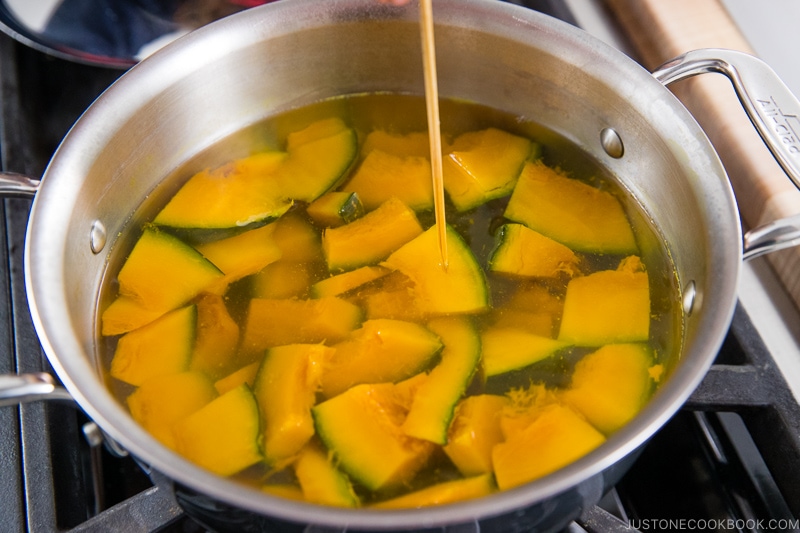
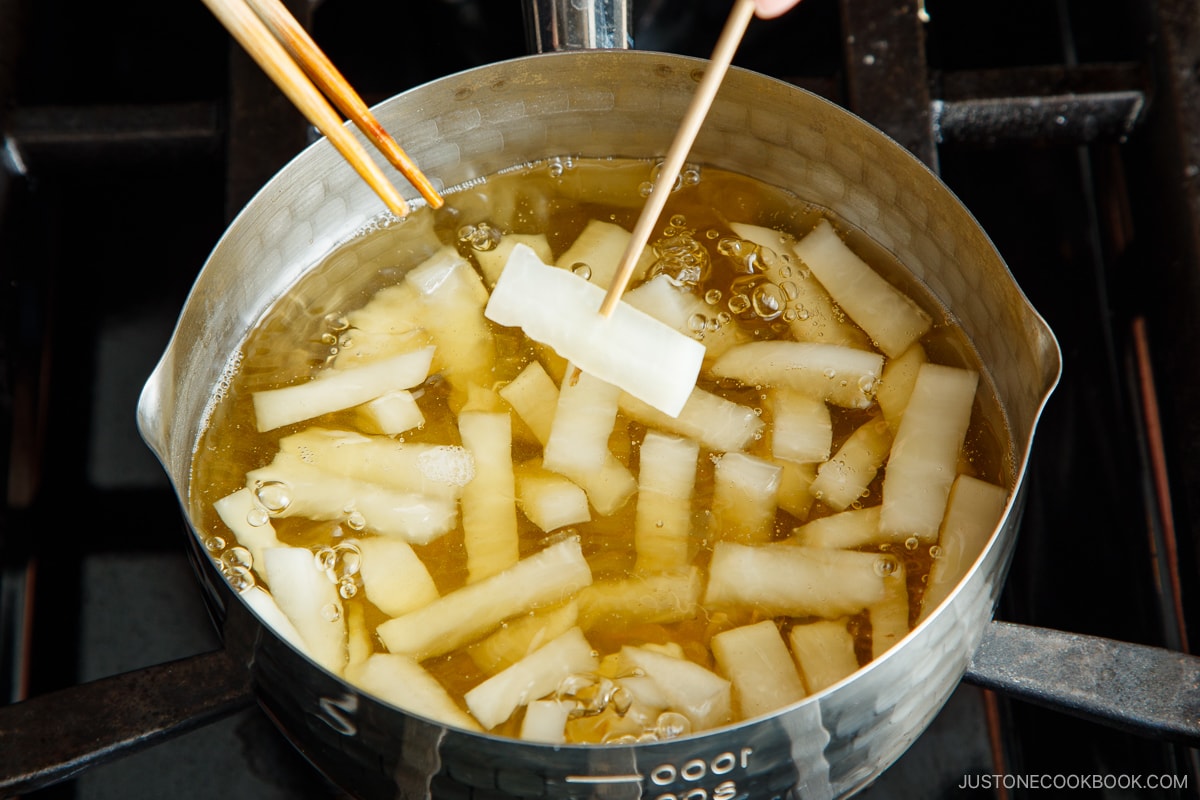
- For leafy vegetables and mushrooms, add them to simmering dashi (with or without other cooked ingredients) and cook for a few minutes.
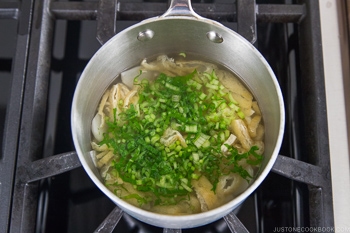
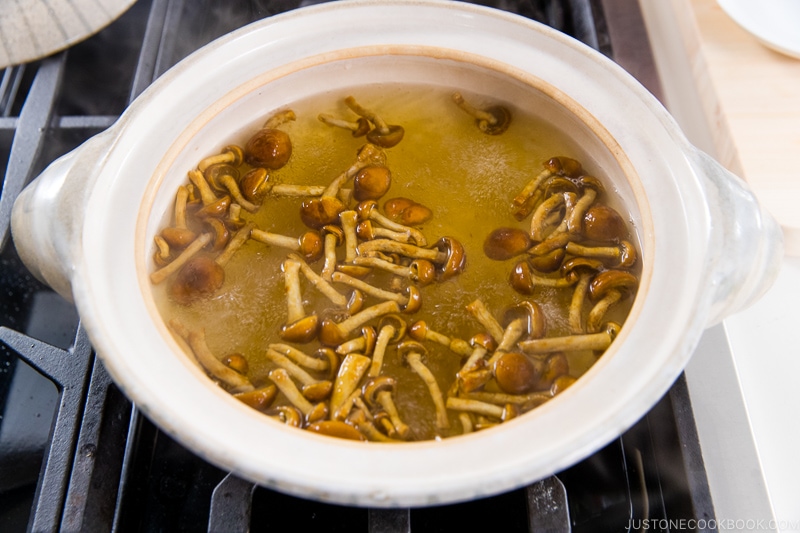
- For miso soup with seasonal ingredients, check out my Just One Cookbook Miso Soup Recipes.
Health Benefits of Miso Soup
I drink miso soup daily, as I believe it’s a delicious and healing gateway to excellent health. Much like green tea, I’d say miso soup is the elixir of the Japanese diet. Here are just a few health benefits I’ve found from miso soup:
- Good source of nutrients. Miso is rich in essential minerals like copper, manganese, protein, Vitamin K, and zinc. For me, drinking a bowl of miso soup daily is like taking a natural supplement for my health.
- Good for bones. Miso soup provides many bone-building minerals like calcium, magnesium, and manganese, which help reduce the risk of developing osteoporosis.
- Improve heart health. The natural compounds in miso, like Vitamin K2, linoleic acid, and saponin, are known to reduce the risk of heart disease and lower cholesterol.
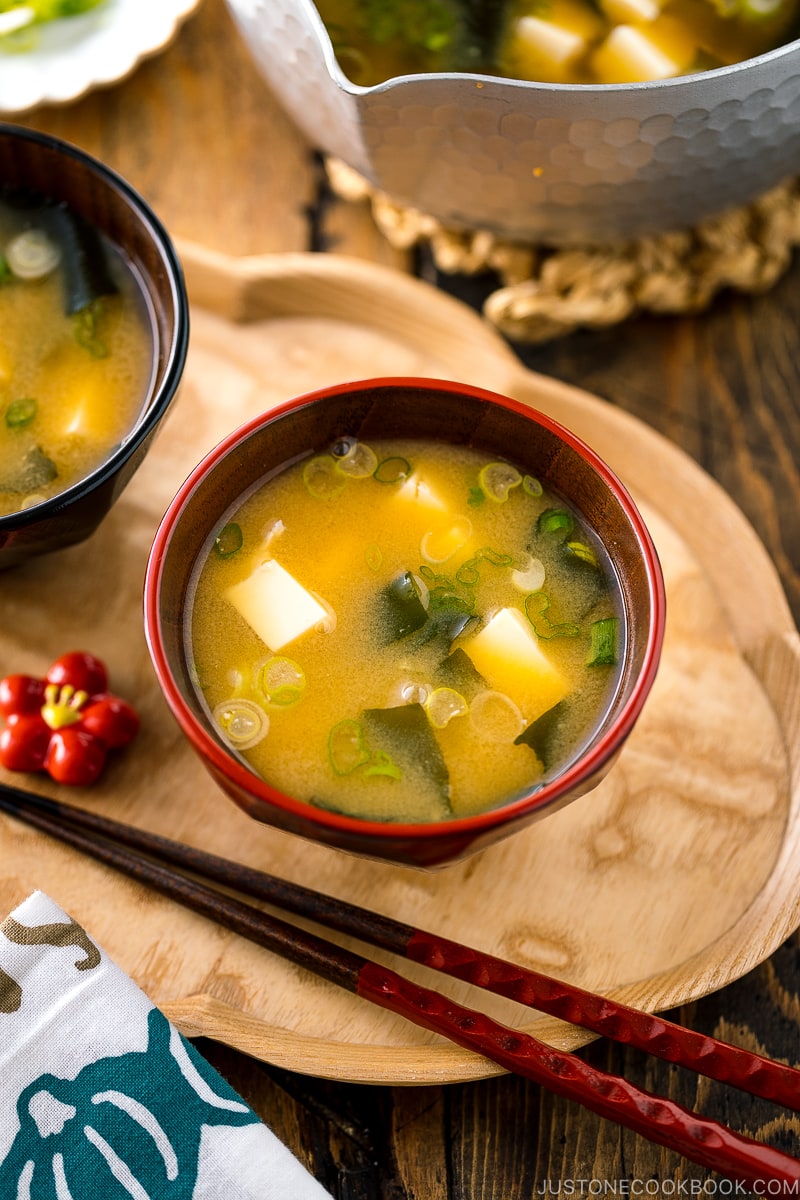
6 Key Takeaways to Remember
- You can make a big batch of dashi and store it in the refrigerator for 3–5 days for convenience.
- Add miso right before serving for the best fragrance and taste!
- Bring dashi to a slow boil (around 205°F/96°C), then turn off the heat before adding miso. This temperature ensures the best aroma and flavor of miso soup. When it’s time to serve, the soup will be at an ideal drinking temperature of 167ºF (75ºC).
- Use 1 tablespoon of miso per 1 miso soup bowl (200ml), and adjust the taste. To avoid clumps, dissolve miso first in a ladle, a separate bowl, or a miso strainer before adding it to the dashi.
- Add tofu, wakame, and green onions after the miso is dissolved.
- Never bring miso soup to a full boil, as this will diminish its flavor and aroma.
Now that you’ve learned how to make miso soup at home, I hope you enjoy this nourishing soup every day!
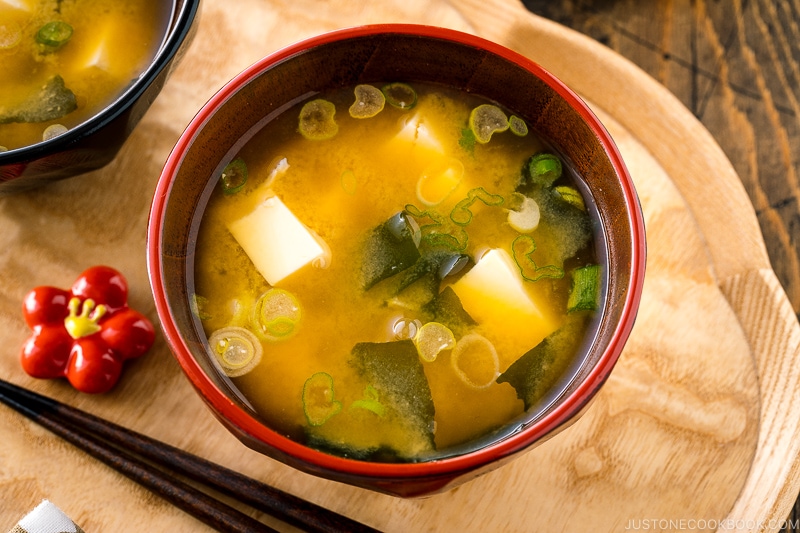
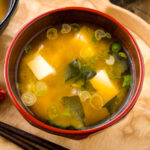
Homemade Miso Soup with Tofu
Video
Ingredients
For the Dashi (makes a scant 4 cups)
- 4 cups water
- 1 piece kombu (dried kelp) (⅓ oz, 10 g per piece; 4 x 4 inches or 10 x 10 cm)
- 1 cup katsuobushi (dried bonito flakes) (packed; I used a loosely packed 3 cups in the video for stronger flavor)
For the Miso Soup
- 7 oz soft/silken tofu (kinugoshi dofu)
- 4 Tbsp miso (use 1 Tbsp, 18 g for every 1 cup, 240 ml of dashi)
- 1 Tbsp dried wakame seaweed
- 1 green onion/scallion
Instructions
- Before we start… I make Awase Dashi with kombu and katsuobushi in this recipe. You can also make dashi with a dashi packet or powder. For vegan/vegetarian, make the Kombu Dashi I showed below or make Vegan Dashi with kombu and dried shiitake mushrooms.

- Gather all the ingredients.
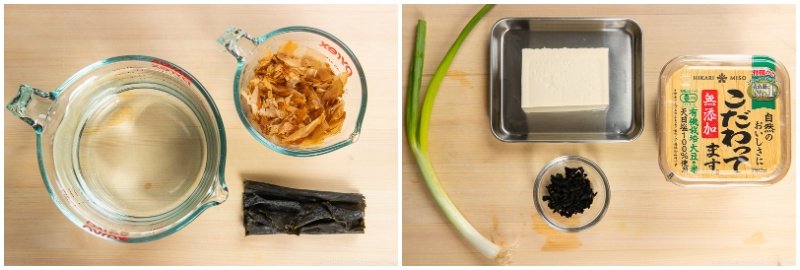
- Cut 1 green onion/scallion into thin rounds.
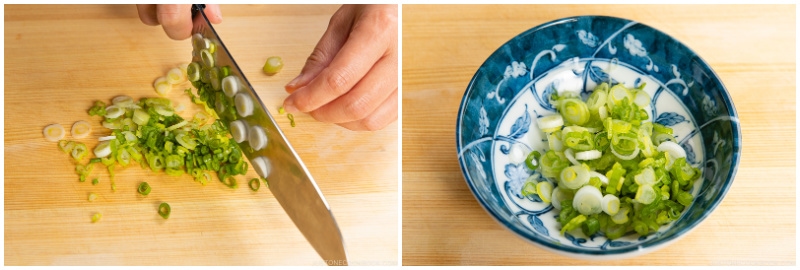
To Make the Dashi (can make in advance)
- Add 4 cups water and 1 piece kombu (dried kelp) to a medium saucepan. If you have time, soak the kombu in water for 30 minutes. NEVER wash kombu and do not remove the white substance—that’s umami! These days, it‘s pretty clean, so just make sure there are no dirt particles.
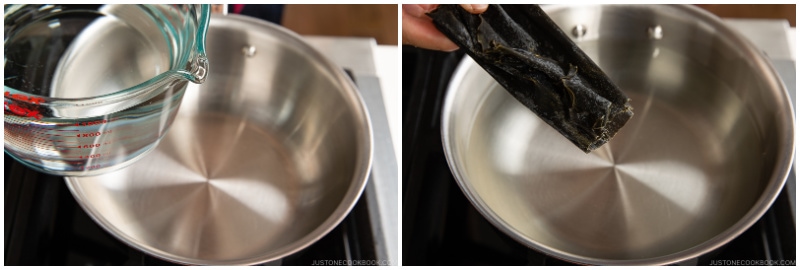
- SLOWLY bring it to a boil (about 10 minutes) on medium-low heat so you can extract as much umami from the kombu as possible. Right before the stock boils, remove the kombu and set it aside for another use. (If you leave the kombu, it gets slimy and yields a bitter taste.) Now, what you have is Kombu Dashi. If you’re vegetarian/vegan, use this kombu dashi for your miso soup.
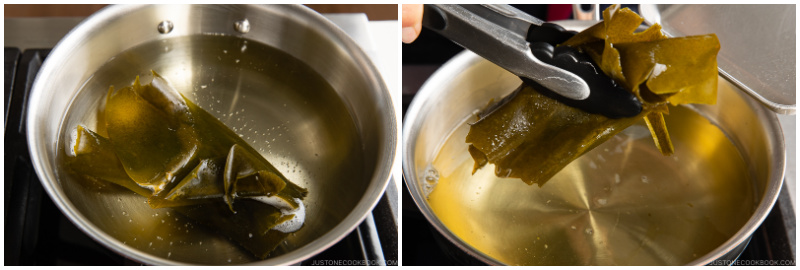
- If you‘re not vegetarian/vegan, add 1 cup katsuobushi (dried bonito flakes) to the kombu dashi and bring it back to a boil again. Once the dashi is boiling, reduce the heat, simmer for just 30 seconds.
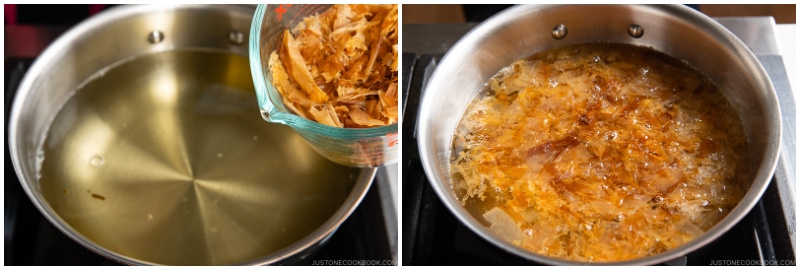
- Turn off the heat and let the katsuobushi sink to the bottom, about 10 minutes. Then, strain through a fine-mesh sieve.
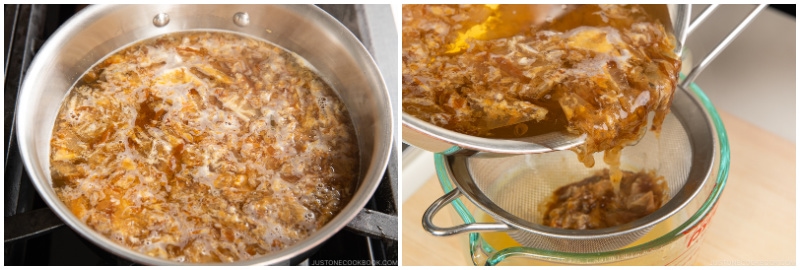
- Now you have roughly 4 cups of Awase Dashi. You can store the dashi in the refrigerator for up to 3–5 days and in the freezer for up to 2 weeks. Reserve the spent katsuobushi and repurpose it; see the suggested recipes that follow at the end of the instructions.
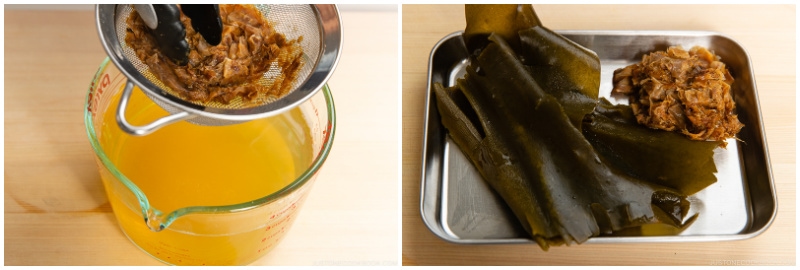
To Make the Miso Soup
- Add the dashi to the saucepan. If you are using dashi from the refrigerator, bring it to a slow boil (205°F/96°C) over medium heat and turn off the heat.
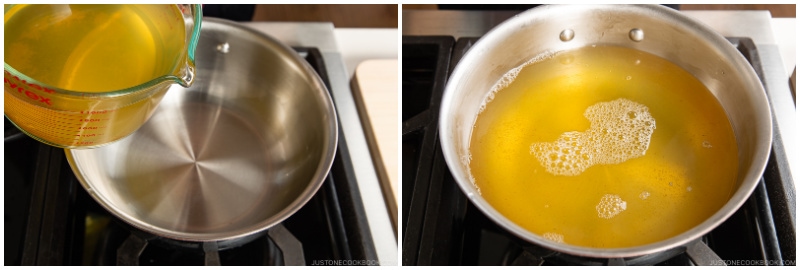
- Add 4 Tbsp miso. Put the miso in a ladle, slowly add the dashi into the ladle, and stir with chopsticks to dissolve completely. Here, I‘m using a miso muddler. If you accidentally add too much miso, dilute the miso soup with dashi (or water).
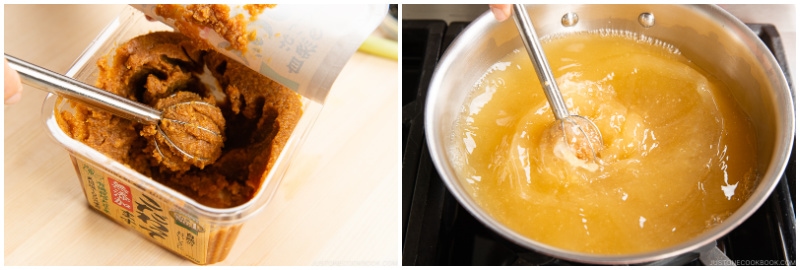
- Here, I‘m using a fine-mesh miso strainer, which helps you dissolve the miso faster. After dissolving the miso in the strainer, you may see rice koji (especially when it‘s koji miso). It‘s up to you if you want to include it in the miso soup or discard it (personal preference).
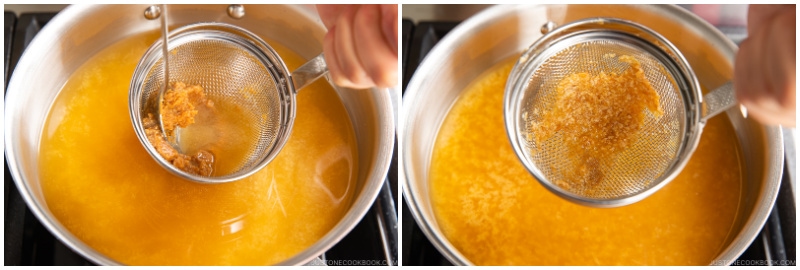
- Cut 7 oz soft/silken tofu (kinugoshi dofu) into ½-inch (1.3 cm) cubes and add to the miso soup. Tip: Add the tofu after the miso is completely dissolved; otherwise, you might break the tofu when stirring in the miso. Note: It is very common to cut tofu on your palm in Japan. However, I recommend using a cutting board if you have never done this.
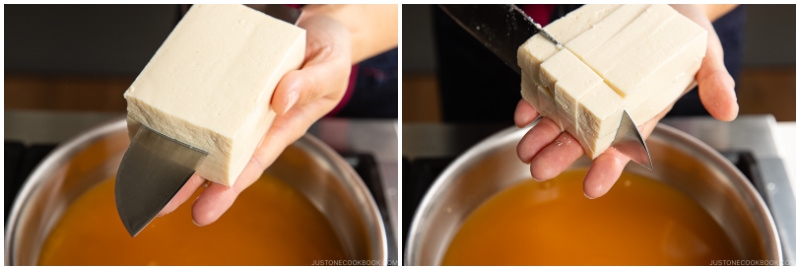
- Add 1 Tbsp dried wakame seaweed and the chopped green onions to the pot right before serving to keep their fresh fragrance and color. Tip: If you worry about salt intake, I recommend rehydrating the dried wakame in a separate bowl of water to get rid of the saltiness, instead of rehydrating it in the soup itself. If reheating, warm up the miso soup until it is just hot. NEVER BOIL miso soup because it loses flavor and aroma.
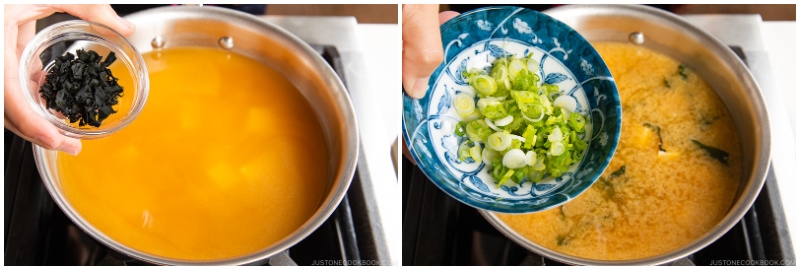
To Serve
- Serve immediately. Place on the right side of the table setting; you can read about this in my post Ichiju Sansai (One Soup Three Dishes).
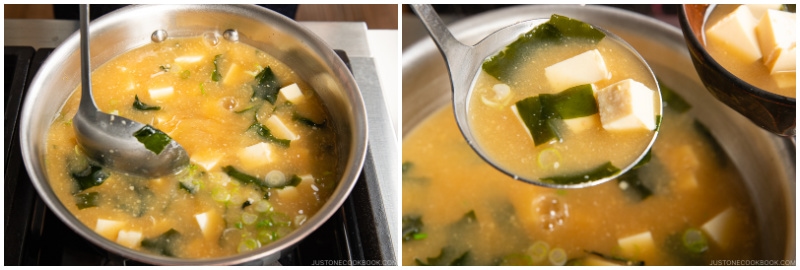
To Store
- In general, it‘s best to consume all the miso soup right away because it will lose its aroma and taste as time passes. Let your miso soup cool to room temperature (up to 4 hours; any longer and it will spoil) and then refrigerate. Keep for up to 2 days in the refrigerator. If you want to make a big batch to store for later, it‘s best to refrigerate the soup without adding the miso. When ready to use, add the miso only for the portion you need. You can freeze miso soup for up to 2 weeks. However, you have to remove the tofu before freezing as the texture will change.
To Reheat the Miso Soup
- Heat the miso soup in a pot over medium heat, but do not boil. Miso loses its nutrients, flavor, and aroma at high temperatures.
What to do with the spent katsuobushi and kombu?
- Save the spent kombu and katsuobushi in an airtight container and store it in the refrigerator for a week or in the freezer for up to a month.
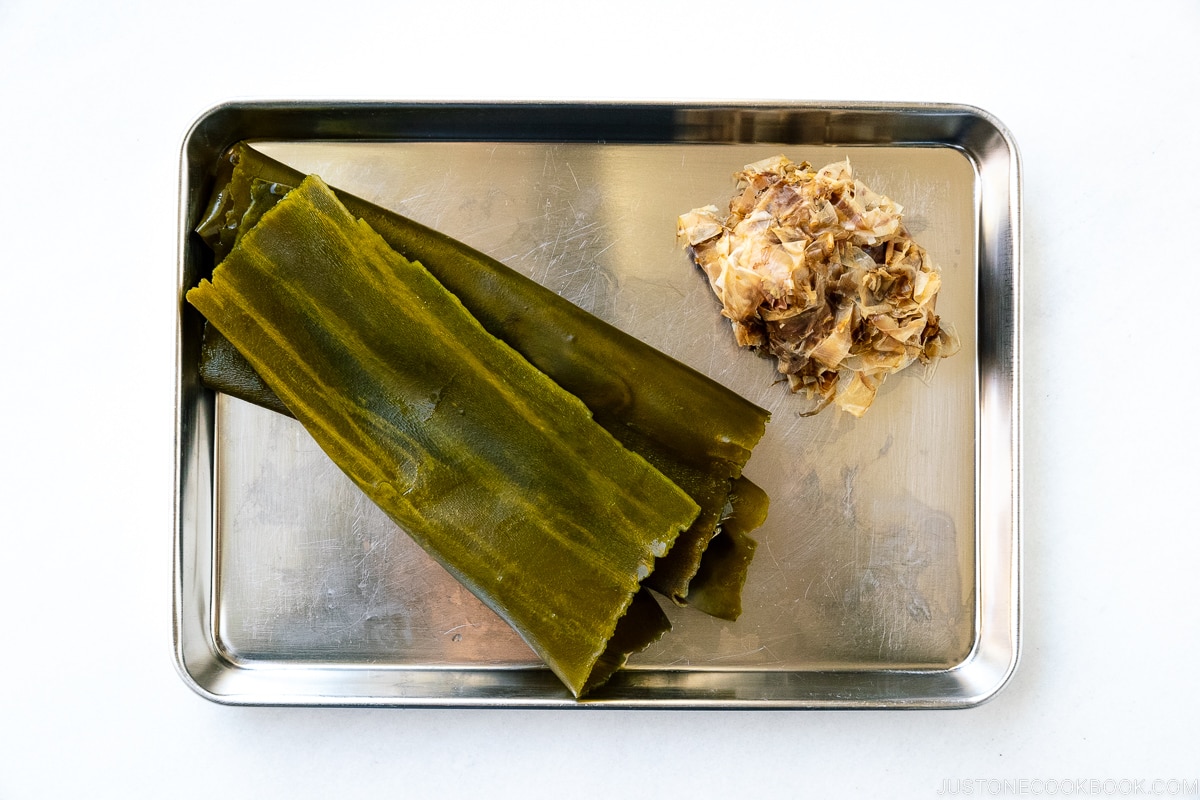
- With the spent kombu, you can make Simmered Kombu (Kombu Tsukudani).
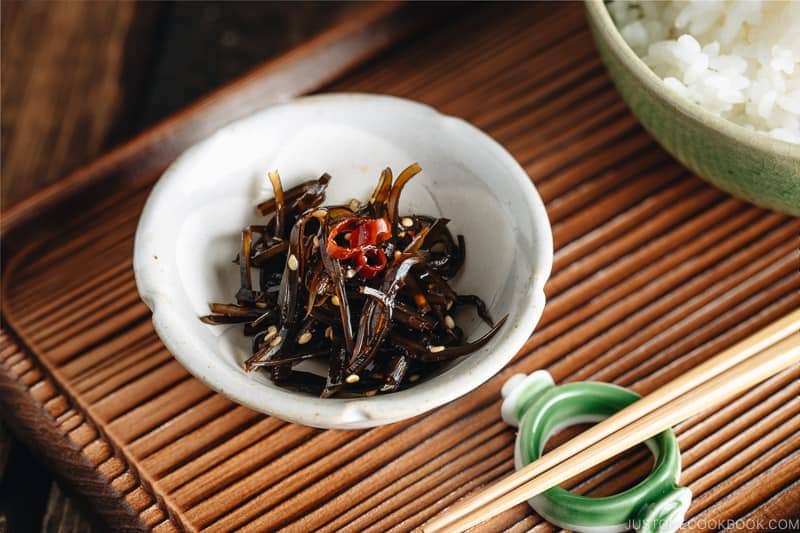
- You can also make Homemade Furikake (Rice Seasoning).
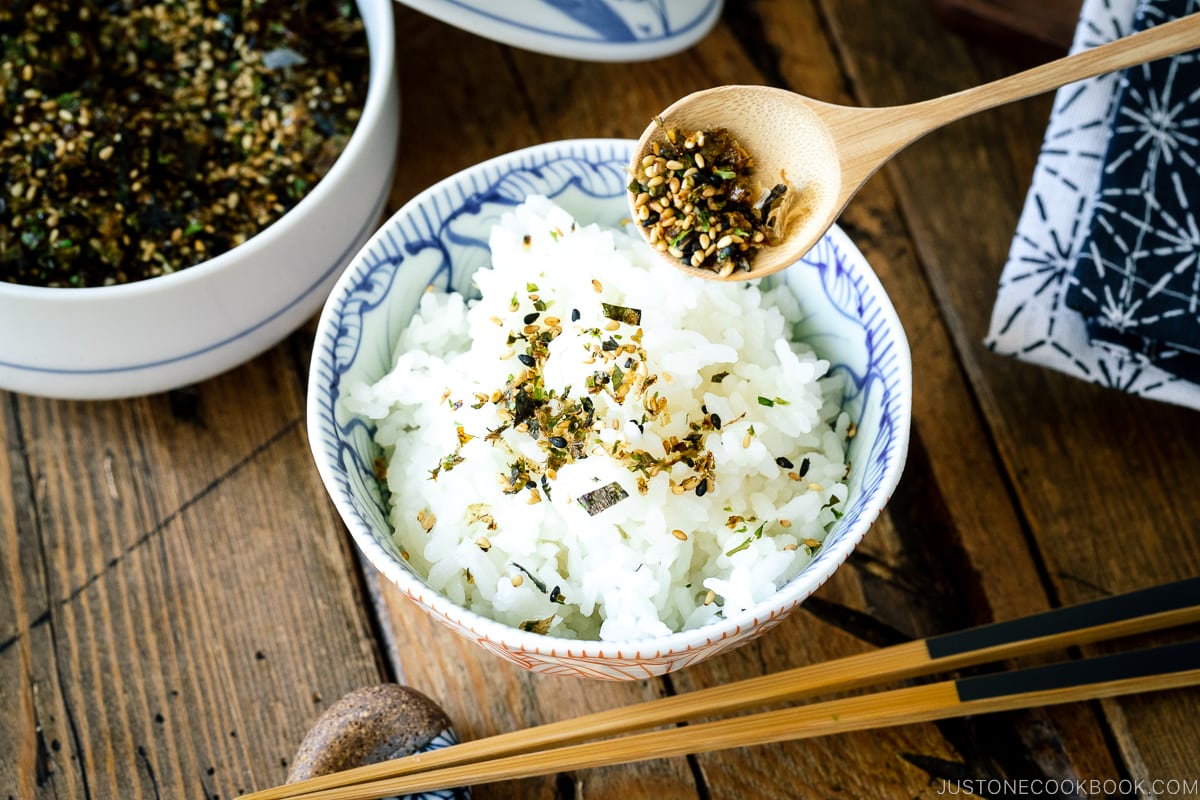
Nutrition
Editor’s Note: The post was originally published on Mar 3, 2011. The recipe was revised and updated on June 7, 2022. The post was updated with new images, a new video, and more helpful content on February 2, 2024.

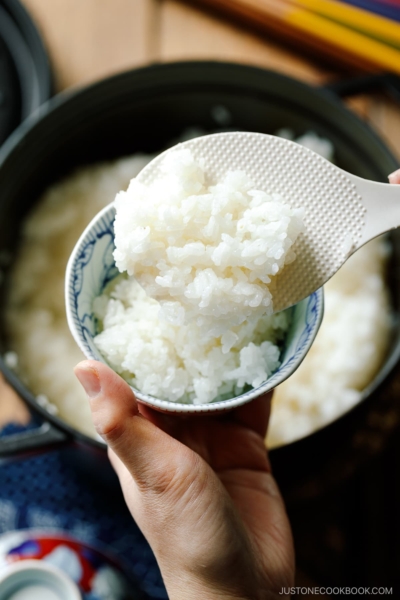

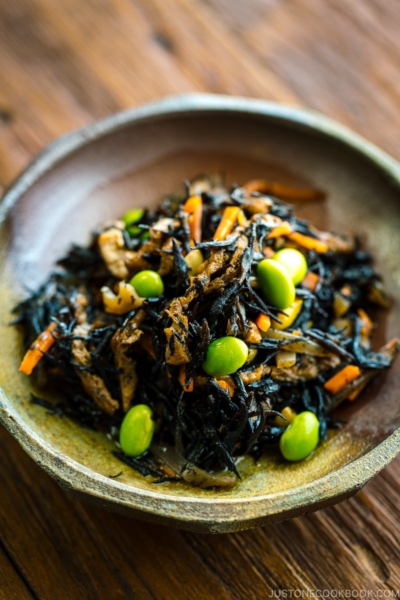




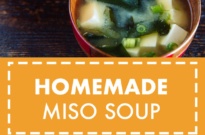
Nami, we’ve made your miso soup twice in the past three days:) First me and then my daughter… The taste was amazing and the soup was so easy to prepare. This will definitely be a recipe we’ll use again and again.
Hi Heather! So happy to hear you enjoyed the miso soup recipe! It’s easy enough that we drink everyday (with different ingredients) in Japan (when we serve Japanese food). Thank you so much for your kind feedback! 🙂
Thank you so much for the recipe! I went to the Asian market down the street and got all the ingredients I need. I do have some questions however. Is it ok to make a big batch and save it in the fridge or does it have to be eaten that day? Also I do not have a miso strainer (or strainer small enough to fit in the pot) could I whisk in the miso or is the strainer imperative?
Hi Amber! Great to hear you found all the ingredients! Personally I won’t keep miso soup for more than 2 days. I make dashi and keep it for a week, but I always make fresh miso soup (it only takes a few minutes since I already have dashi ready to heat up). Miso soup is considered tasty when you make it fresh – but it may not be obvious if you don’t drink miso soup everyday. 🙂 So in that case, you can make a big pot, but try to finish it in 2-3 days with tofu in it (keep in the fridge and heat up). For the strainer, don’t worry! If you have a ladle, use a ladle instead. You basically don’t want to drop the miso directly into the pot as you can’t see if it has dissolved or not and you might add more miso… 🙂 Some people take out the dashi from the pot into a bowl and add miso to mix. But to me, it’s easier to use a ladle. Hope this helps! Enjoy!
I love love love miso soup and I so want to make this. What is the best type of dashi packet or powder to buy?
Tracy
Hi Tracy! I use these brands shown in the post (toward the end of post).
https://www.justonecookbook.com/how-to/how-to-make-dashi-jiru/
I can get these from Japanese supermarkets around where I live. I’m not sure where you’re located, but you can try Amazon too.
This looks wonderful. I only have firm tofu on hand. Could I use that?
Hi Kerry! Sure, it’s up to your preference. I like soft tofu for miso soup, but when I only have medium firm, I use it too. 🙂 Hope you enjoy!
Hi Nami
I need help choosing Miso paste. I purchased what’s called Hatcho Miso, which was very thick and had (by itself, right out of the package) a very strange taste, almost black color and the consistency of tar. It is unpasteurized and supposed to be a very traditional miso in Japan.
The little packets of miso I get with my instant miso soup mix are very different – much thinner consistency and a yellow color. make excellent soup.
What brand of miso do you use, and what is a good internet source in the USA?
Thanks!
Hi Bill! Hatcho miso is fermented for a long time and it’s salty and not sweet like other lighter color miso. This miso is used for miso soup in Nagoya area, but not a common miso soup miso.
Most of miso used in packages are shiro miso (white miso) or awase miso (mixed miso – red and white miso). They are more mild and you’re familiar with the taste of this miso.
I love Hikari Miso brand and have been using for close to 10 years.
https://www.justonecookbook.com/pantry/miso/
I can find this brand at my local Japanese supermarket and an Asian grocery store.
Japanese grocery items can be purchased on line at the followings.
Amazon
http://www.marukaiestore.com/
http://store.mitsuwa.com/storefront.aspx
http://www.asianfoodgrocer.com/
I made it yesterday. It was too much salty, I don’t get why. I used kombu dashi and red miso. Maybe, I got the dosage wrong. Also, please, I got two questions: a part of red miso, something like bran, remain in the strainer, should I put it away or not? Do I have to use the whole scallion or only the white part or the green one?
Hi Fabio! Thank you so much for trying this recipe. Red miso is much saltier than Mixed (Awase miso) or White (Shiro miso), so I assume you just added a bit too much. When that happens, you can simply dilute with dashi (if you have extra – but most likely that doesn’t happen…) or water (hot water preferably). I usually guess the amount of miso, and once in a while I put too much. So I end up diluting to adjust. 🙂
Some miso includes parts of soy beans. They are edible too. It’s up to your preference. My mom usually removed it (as we use the special miso strainer (see step 4) that we can actually take it out), but I’m okay with out without it. So it’s up to you. 🙂
Scallion is also up to preference. I like to use both green and white part, and maybe put 1/2 Tbsp. for each bowl.
Hope this helps!
Hi! 🙂 – Thank you! I’ve just made and eaten it. I’ve added only three teaspoons of red miso. It’s good this time. – I make kombu dashi only to make miso soup till now. Kombu dashi recipe serves 3½ cups and miso soup recipe need 3 cups of it. How much kombu (grams) and water (ml) should I use to make only those 3 cups of dashi for this recipe?
Hi Fabio! Good part of miso soup is that ingredients are simple, and easily adjusted unlike some soup recipes that require pretty specific amount of certain ingredients. So, I recommend you to add just a bit of more miso for the the extra 1/2 cup. Since kombu dashi is more subtle flavor, you could also reduce water amount and make 3 cups instead. They don’t really affect much for the whole flavor. I know this is kind of “cheating” but it doesn’t have to be precise for dashi or miso soup recipe. Hope I’m not making this even more complicated. =P
I’m always careful to follow perfectly recipes, but, if you say that, it’s even better. 🙂 – Last one: I’ve found slices of dried lotus root. Do you think is it a good idea make dashi using it? Is there anything like “lotus dashi” in Japan?
Hi Fabio! Hmm slices of dried lotus root won’t probably make good dashi, and no, we don’t have lotus dashi. 😀 However, it’s a good ingredient for miso soup, too. 🙂 I make Pork & Veggie miso soup (https://www.justonecookbook.com/recipes/tonjiru/) with all kinds of root vegetables, including lotus root. 🙂
OK! – Thanks for your help and advice. 🙂
You’re very welcome! 🙂
It is very nice to find your recipe on this site. We just tried to make miso soup tonight before I read this. I didn’t cook the miso, instead, I put it in the bowl and pour the dashi soup base in, but it tasted sour 🙁 May I ask your advice?
Hi Rane! Thank you for finding my site, and welcome to Just One Cookbook! I’m not too sure why it was “sour”. There is no sourness in miso soup component…. How did you make dashi? Powdered dashi, made from scratch, or used something else? And what kind of miso paste did you use?
Hi! Nice I got your response. I think it is not the dashi matter. It is the miso itself? Because I tried to boil the water and put tofu and green onion in, also I put the same miso paste at the end. It still tasted sour. I bought the regular miso, it indicated aka miso on the label.
Thank you for your response!
Hi Rene! Assuming that you tried miso soup before (and know the taste), I think you’re probably not fond of aka miso. It has more distinct flavor (at least to me) and quite different from Shiro miso (white miso) or Awase miso (this is combination of shiro and aka). Each miso brand and type has different flavor so you may like other brand of aka miso too… Hope you don’t mind testing different brands and see which one you like. It took me several years and many different brands to see what brand I like. 🙂 (https://www.justonecookbook.com/pantry/miso/)
Thank you very much for this recipe! In our house, miso soup is curative. It’s the first thing we offer when someone is not feeling well because it is guaranteed to make us feel better. We’ve only ever used the packaged soup which is okay but not anywhere nearly as good as what we’ve eaten at Japanese restaurants. Just recently we found your site and this recipe. Thank you so much, especially for the instructions and illustration on how to cut soft tofu.
The soup we made this evening was delicious! The first time we try out a new recipe we always follow instructions and don’t make any changes, additions, or subtractions. Your directions are very clear and easy to understand and follow and we appreciated that a lot. For our next try we plan to add mushrooms and/or vegetables other than seaweed.
We also hope to locate an Asian grocer where we can find the ingredients to make dashi from scratch. We bought the powdered kind and it was great but we’d like to get away from the MSG.
Thank you again for your excellent instructions and informative comments.
Hi Annie! I’m so happy to hear you tried this recipe! These days there are MSG-free powdered dashi (but usually imported from Japan), so you might want to check that out too. Homemade dashi is very easy to make (much easier than making chicken/vegetable broth), and I hope you will make miso soup with homemade dashi. Very delicious! 🙂 Thank you again for your kind feedback!
I am am making miso soup tonight and I was trolling around the Web for recipes and I came upon your blog. It is very interesting and informative and since I want to try making some Japanese recipes, I think I will referring to it a lot! I had to go to Amazon to get dashi and awase miso. it’s hard to find here in Minnesota! So wish me luck on my miso!
Hi Lisa! Welcome to my blog. 🙂 So happy you found my blog! I hope you enjoy cooking Japanese foods. Once you get dashi, mirin, sake, soy sauce, miso, you’re pretty much all set to cook most of Japanese food. 🙂 Hope you enjoy homemade miso soup!
Hello Nami,
Thank you for a very informative and well-produced blog. Regarding dashi, I have 2 questions/comments. I used to buy a 1 lb. box of Hondashi of a well-known brand but no more; reason, the first two ingredients are salt, glucose, etc! Regarding katsuo, the only flaked bonito easily available in most of the US hana katsuo, better for furikake than for dashi. The dark katsuo for dashi is not really found here. Niboshi or sardine/anchovies are found in Korean stores and their dashida can be prepared at a lower expense. While not katsuo-dashi, different dashi-s exist in Japan, do they not, in addition to vegetarian ones? Could you please teach us alternatives to the bonito dashis? Thank you very much.
Hi Gautam! Thank you so much for reading my blog!
Yes, I am also not a fan of Hondashi or similar brand and don’t use them. However, I have MSG-free powder dashi from Hikari Miso and this one is pretty decent (and I use it when I need a bit of dashi flavor, but never used in my blog).
Katsuobushi – I live very close to several Japanese supermarkets here in SF and I am not familiar with the rest of US, so thank you for your feedback. 🙂 I use Hana Katsuo or big flake katsuobushi for making dashi, instead of small katsuobushi.
I’m going to make Iriko Dashi post soon. This is much easier to make as you mentioned because Korean stores always carry anchovies.
Dashi in Japan include:
Awase Dashi (kombu + katsuo),
Kombu Dashi (vegetarian),
Katsuo Dashi
Iriko Dashi
and Shiitake Dashi – this is a bit unique one. We soak dried shiitake and keep the liquid for dashi.
That’s it. Only 4 (or 5 if you include shiitake).
In case you haven’t read, here’s dashi post:
https://www.justonecookbook.com/how-to/how-to-make-dashi-jiru/
Hope this helps. 🙂
Lovely blog! My son loves miso soup and I’m glad to find your recipe 🙂 I can add ramen too right?
Hi Jude! Thank you! I hope you enjoy my miso soup recipe. Well, just to note that adding ramen in miso soup won’t be like miso ramen…. Ramen is not a good noodle to put in miso soup, unless you really want to add… I’d recommend somen noodles or udon noodles. Ramen is a bit awkward, but it’s up to you! 🙂
Is that so? Thanks for telling me. I don’t know anything about Japanese food except for tempura, sushi and ramen haha! For this year, I want to enchant the dishes I cook for my family so I’ve been trying other Asian recipes. I’m so happy i chanced upon your blog . Excited to learn more….but I need to find a Japanese grocery near our place to buy my miso paste and dashi 🙂
Hi Jude! I mean, it’s up to your preference I guess. But you will not find ramen noodles in miso soup in Japan. Something that we don’t put in miso soup. 🙂 Miso should be pretty easy to find and some American stores like Whole Foods even carry it. For Dashi, you can buy an instant dashi (powder), but if you want to make it from scratch, you may need to visit Japanese or Korean or Asian markets to buy kombu (dried kelp) and katsuobushi (dried bonito flakes). Hope you give it a try! 🙂
I totally forgot about those little packets! My mom used them, thanks for the sweet memory
Hi June! No problem! Those packets are so easy for daily use. 🙂
May I know at what age is it appropriate for a child to try miso soup?
Hi Anthea! Just like for all the foods, you should be careful to introduce a new food because your child might have an allergic reaction to certain foods. Please consult with your baby’s pediatrician first.
In general in Japan, we start feeding miso soup right before a baby turns 1 year old. Instead of giving “regular” (adult) miso soup, we dilute miso soup so that salt content is not too strong, maybe dilute about 4 times. You can scoop the top layer of miso soup (less salty) and dilute it.
Again, I recommend you to consult with your baby’s pediatrician first. 🙂 Hope that helps!
Thanks Nami for your reply. He is coming to 2yo in November and we will be heading to Tokyo for the big day 😉 Since we are going to Japan, thought of letting him try out all these common food first before going there. Here in Malaysia, I’ve asked his doctor before about some of those high allergen food, he said once he turned 1yo should be ok to try everything – except for half cook or raw food.
hello! my name is marcela and i am from brazil. I would like to thank you for posting this amazing recipes. I made almost everything and they taste like heaven. I can not explain my gratitude for this website. I thank you from heart for your recipes.
thank you
ps: soory for the poor english is not my native language
Hi Marcela! I understood your English perfectly. I do struggle writing and speaking in English too and I’m not 100% comfortable. 🙂
I’m really happy to hear you enjoy my recipes and thank you so much for your feedback. Let me know if my English explanation is not clear, etc. I’d be happy to help. Thanks again!
Hi Anthea! I see! That’s very good idea. You will be drinking miso soup if rice is served to the meal. 🙂 Hope you enjoy a trip to Japan! 🙂
This is a great nutritional value, vegetarian and delicious soup!! I love your recipes.
Hi Maria! Thank you so much for your kind comment. Yes, miso has a wonderful nutritious benefit (only thing we need to worry is the salt content – make sure you don’t put too much). I am glad you enjoy my recipes! Thanks for writing! 🙂
Not sure how much it matters, but I can’t find Japanese branded tofu. I can only get tofu with Korean, Chinese, or all English on the package. Last time I chose the organic Korean soft tofu. I was wondering if Japanese tofu had a different taste? The one I used tonight was good, but had a kinda strong flavor. The texture didnt look like the one in your picture… It’s soft and not silken tofu? Thanks!
Hi Steven! I on the other hand never bought non-Japanese brand tofu, so it’s hard to say (plus there are many brands available for Korean and Chinese). I think Korean, Chinese and Japanese soft tofu are pretty similar. Or at least when I eat at the restaurant, the tofu seems “similar” if not “same”. Each brand also makes tofu very differently too, so if you think the one you tried had a strong flavor, you may want to try a different brand. For this recipe (particularly this photo shoot), I’m using Japanese brand tofu, and it’s very smooth and silken. You can put any kinds of tofu (there is no rule what kind of tofu to use for miso soup). Hope this helps. 🙂